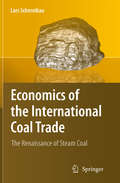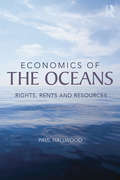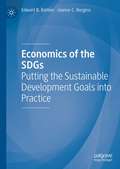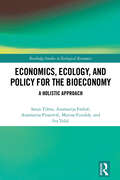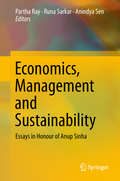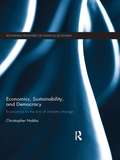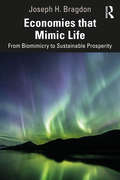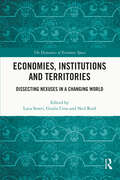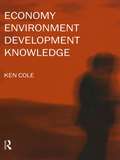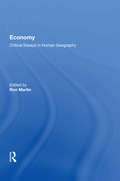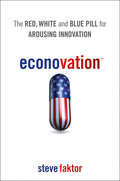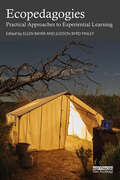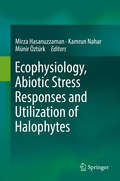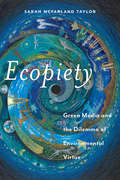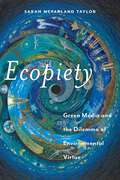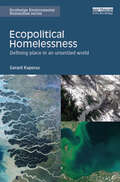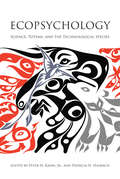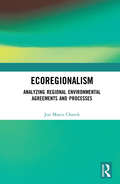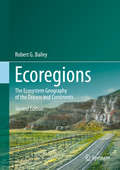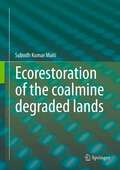- Table View
- List View
Economics of the International Coal Trade: The Renaissance of Steam Coal
by Lars SchernikauThe world today depends on oil, coal and gas (in that order of importance) for over 80% of its primary energy. From the time humans tamed fire, wood or bio-mass became the primary energy source. Coal took over from biomass during the Industrial Revolution and accounted for over 60% of world primary energy by the early 1900s. The current age is often referred to as the Oil Age, which seems appropriate now that about 35% of the world's primary energy still comes from oil. However, coal is experiencing a renaissance. Today about one quarter of the world's primary energy and more than 40% of the world's electricity comes from coal. In addition, about two thirds of the world's steel is produced using coal. The author predicts that coal will become even more important in the decades to come, mainly driven by demand from China and India. This book focuses on the role of coal for today's energy and, most importantly, electricity markets. It starts with a review of coal as a resource, profiling the major steam coal exporting nations and the structure of the supply market. The low investment rate in coal compared to other fossil fuels is discussed, and environmental and safety issues with coal production are reviewed. The book examines how coal is used in the modern world. It compares coal to other energy resources and speculates on a greater role for coal in the medium-term future. It examines the structure of the steam coal market, contract terms, derivative markets, FOB costs, and introduces the WorldCoal market model. The final chapter summarizes conclusions and predictions. The author predicts more and larger merger attempts in the coal supply arena and further efforts to manage this development through public policy, greater investment by market participants in logistics and upstream assets, and the development of exchange-based coal trading through standardized coal volumes. The author also outlines why he believes coal prices will rise, eventually catching up with gas.
Economics of the Oceans: Rights, Rents and Resources
by Paul HallwoodIt is an unfortunate truth that our oceans offer valuable resources that are too often used unsustainably. Time and again this is due to the failure of international law to provide a framework for adequate governance. Economics of the Oceans examines this issue and provides a comprehensive study of ocean uses from the perspectives of law and economics. Themes covered in the book include ocean governance, the economics of oceanic resource exploitation, offshore oil, coral reefs, shipwrecks and maritime piracy. Analytical techniques such as basic game theory, environmental economics of the commons and cost-benefit analysis are employed to illuminate the topics. This book will be of interest to students of environmental economics, natural resource economics and management, and the economics of international law as relating to the oceans.
Economics of the SDGs: Putting the Sustainable Development Goals into Practice
by Edward B. Barbier Joanne C. BurgessThis is the first book that employs economics to develop and apply an analytical framework for assessing progress towards the Sustainable Development Goals (SDGs). The authors explore the historical context for the underlying sustainability concept, develop an economics-based analytical framework for assessing progress towards the SDGs, and discuss the implications for sustainability policy and future research. Economics is concerned with analysing the trade-offs in allocating scarce means to achieve various ends. Thus, economic methods are ideally suited to assessing how progress towards one or more SDGs may come at the expense of achieving other goals. Such interactions are inevitable in meeting the 2030 Agenda over the next decade, given that the SDGs include different economic, social, and environmental elements. Although it may be possible to make progress across all 17 goals by 2030, it is more likely that improvement toward all goals will be mixed. For example, we may have reduced poverty or hunger over recent years, but the way in which this progress has been achieved – e.g. through economic expansion and industrial growth – may have come at the cost in achieving some environmental or social goals. On the other hand, progress in reducing poverty is likely to go hand-in-hand with other important goals, such as eliminating hunger, improving clean water and sanitation, and ensuring good health and well-being. Assessing these interactions is essential for guiding policy, so that countries and the international community can begin implementing the right set of environmental, social and economic policies to achieve more sustainable and inclusive global development.
Economics, Ecology, and Policy for the Bioeconomy: A Holistic Approach (Routledge Studies in Ecological Economics)
by Sanja Tišma Anamarija Farkaš Anamarija Pisarović Marina Funduk Iva TolićThis book demonstrates that a holistic approach to the bioeconomy is essential if it is to achieve its full potential in driving economic growth while simultaneously providing ecological, social and technological benefits. Definitions of the ‘bioeconomy’ vary but in general it incorporates the ways in which societies manage and distribute their primary or secondary biological resources for further use in everyday life (e.g. food, materials, and energy). The classical sectors related to the bioeconomy have therefore been agriculture, forestry and aquaculture, now extended to include bioenergy, biofuels, biochemicals, and other processing and service industries. There are also related new concepts such us the blue economy, the green economy, and the circular economy. This book integrates these definitions, sectoral analyses and new concepts into a fully rounded study of the bioeconomy. It is argued that the key aims in the coming years have to be the harmonization of public policies between different sectors, regulation of legislative framework for the bioeconomy, and clear communication of these issues. In particular, the book argues that a strengthening of the monitoring and evaluation of the impacts of the bioeconomy on society is an essential starting point. For this to be effective, appropriate indicators need to be established and defined for the monitoring of the effects of these resilient policies related to bioeconomy and their impact on local and regional development and quality of life. This book will be essential reading for anyone interested in the bioeconomy including students and scholars of ecological economics, environmental economics, sustainability, innovation, and regional development.
Economics, Management and Sustainability: Essays In Honour Of Anup Sinha (India Studies in Business and Economics)
by Partha Ray Runa Sarkar Anindya SenThis book presents an eclectic mix of interesting new areas in the domain of economics, management and sustainability. Written by leading experts, it provides valuable food for thought, with essays introducing new lines of research and empirical research papers offering sound research methodology. The book not only provides answers, but also raises numerous interesting questions concerning the areas covered to whet readers’ appetites to learn more. Professor Anup Sinha is a respected teacher and is a great mind with wide-ranging academic interests spanning from economics and sustainability to management. As well as in various other places in India and the US, he has taught at the Indian Institute of Management Calcutta and Presidency College (now a University) Calcutta for almost three decades. To commemorate his contributions, this festschrift presents a collection of essays that are broadly subdivided into four sections: Economic Development; Vulnerabilities and Inclusive Growth; Sustainability and Corporate Governance; and Innovation and Management.
Economics, Sustainability, and Democracy: Economics in the Era of Climate Change (Routledge Frontiers of Political Economy #159)
by Christopher NobbsHow should we conduct economics in an era of climate change, natural resource depletion and population increase? These issues are systemic, and involve great uncertainties and long time horizons. This book contends that the free-market economics that has dominated capitalist democracies in recent decades is not up to the task; that the welfarist economics that preceded it, while preferable, also has inadequacies; and that what is required is an economics founded on ecological principles, greater respect for the laws of natural science, and a moral commitment to a sustainable future. The book commences with an exposition of major aspects of orthodox macroeconomic and microeconomic theory. It then explores the bounds of orthodox theory in relation to ethics, liberalism, ideology, society, the international economy, globalization, and the environment, and seeks lessons for a future economics. Issues raised by natural resource use and climate change are given particular prominence. Many of the issues of critical importance in coming decades involve not private goods but public goods: goods which markets are ill-equipped to deal with. In the resolution of these issues political processes will need to be engaged. The availability to each individual of clean air, clean water and adequate sustenance, goods which cannot be provided for by economic production alone, are of central concern. While acknowledging the importance of market processes, the author argues in favour of a more deliberative and democratic economy, the greater engagement of civil society, environmental human rights and responsibilities, and in favour of a World Environment Organization, change in the conduct of the World Trade Organization, and for economists to accept moral responsibility for the policies they advocate. Specific case studies are given and potential policies outlined. This book will be of interest not only to economists but also to citizens generally and students concerned with public affairs.
Economies that Mimic Life: From Biomimicry to Sustainable Prosperity
by Joseph H. BragdonThe world economy today is at an historical inflection point. The neoclassical (industrial) model of economics is self-destructing while a new life-mimicking model, based on radically different assumptions, is emerging. Although rarely acknowledged in economic journals, Nordic countries, which pioneered the life-mimicking model, have become world leaders in prosperity and productivity while those operating on the older neoclassical/industrial model are trapped in downward spirals. By approaching economies as sub-systems of life rather than super-systems that transcend life, we gain transformative insights. Such thinking led to the first circular economy experiments in Kalundborg (Denmark) during the 1970s, then quickly spread to the rest of the Nordic world. By placing a higher value on living assets (people and Nature) than on non-living capital assets, this approach generates harmony rather than exploitation and conflict. Because Nordic people feel vested in the system and responsible for its success, they are extraordinarily innovative and productive. That is why Nordic companies are regularly rated among the world’s most sustainable and profitable in their fields – even though their region holds less than half of one percent of the world’s population. Written in an accessible way for non-economists, the book is ideal for readers interested in the benefits of biomimicry and methods of guiding democratic countries along a proven path of self-renewal. Economies That Mimic Life will also provide useful background for corporate leaders in scenario planning and strategic thinking. Knowing which way the political-economic wind is blowing will become increasingly important to corporate survival.
Economies, Institutions and Territories: Dissecting Nexuses in a Changing World (The Dynamics of Economic Space)
by Neil Reid Luca Storti Giulia UrsoPresenting multidisciplinary and global insights, this book explores the nexus between economies, institutions, and territories and how global phenomena have local consequences. It examines how original and innovative economic related processes embed themselves in societies at the local level; how boundaries between the state and the market are placed under stress by unexpected changes. It explores whether new types of elites and forms of social inequalities are emerging as a result of institutional and economic changes, and whether peripheral areas are experiencing insidious forms of economic and institutional lock-in. Presenting empirical cases and useful analytical and conceptual tools, the book makes current economic and territorial phenomena more understandable. This is an important read for students and scholars in the fields of geography, sociology, political sciences, anthropology, economics, regional science, and international relations. It is also a valuable resource for policymakers, well-educated lay readers and economic, political and international relations journalists.
Economy-Environment-Development-Knowledge
by Ken ColeAs we approach the end of the second millennium, we find ourselves in times of radical social change. Orthodox explanations of the economy, the environment and the development process are unable to provide coherent policies for such issues as employment creation, environmental degradation and social progress.Economy-Environment-Development-Knowledge provides alternative perspectives on these fundamental aspects of human existence. Economists, environmentalists, and development theorists have so far been unable to agree on the most successful prescriptions to address problems. To understand, contrast and compare alternative understandings of economic, environmental and development issues, we need to be aware why theorists conceptualise the process of social experience so differently.Part 1 of Economy-Environment-Development-Knowledge addresses the subjective preference, cost-of-production and abstract labour theories of values in economics; Part 2 explains egocentrism, ecocentrism and socioecocentrism as competing theoretical perspectives in environmental theory; Part 3 highlights modernisation theory, structuralist theory and class struggle as ways to account for the process of development and Part 4 examines the generation of knowedge through positivism, paradigms and praxis, legitimating competing perspectives in economics, environmentalist and development. The book concludes by considering why different people find alternative explanations more or less plausible.By addressing the disagreements between theorists, Economy-Environment-Development-Knowledge provides a unique basis to contrast and compare the plethora of theories of, and policies for, economic prosperity, environmental sustainability and social progress.
Economy: Critical Essays in Human Geography (Contemporary Foundations Of Space And Place Ser.)
by Ron MartinEconomic geographers have always argued that space is key to understanding the economy, that the processes of economic growth and development do not occur uniformly across geographic space, but rather differ in degree and form as between different nations, regions, cities and localities, with major implications for the geographies of wealth and welfare. This was true in the industrial phase of global capitalism, and is no less true in the contemporary era of post-industrial, knowledge-driven global capitalism. Indeed, the marked changes occurring in the structure and operation of the economy, in the sources of wealth creation, in the organisation of the firm, in the nature of work, in the boundaries between market and state, and in the regulation of the socio-economy, have stimulated an unprecedented wave of theoretical, conceptual and empirical enquiry by economic geographers. Even economists, who traditionally have viewed the economy in non-spatial terms, as existing on the head of the proverbial pin, are increasingly recognising the importance of space, place and location to understanding economic growth, technological innovation, competitiveness and globalisation. This collection of previously published work, though containing but a fraction of the huge explosion in research and publication that has occurred over the past two decades, seeks to convey a sense of this exciting phase in the intellectual development of the discipline and its importance in grasping the spatialities of contemporary economic life.
Econophysics and Companies: Statistical Life and Death in Complex Business Networks
by Hideaki Aoyama Yoshi Fujiwara Yuichi Ikeda Hiroshi Iyetomi Wataru SoumaEconophysics is an emerging interdisciplinary field that takes advantage of the concepts and methods of statistical physics to analyse economic phenomena. This book expands the explanatory scope of econophysics to the real economy by using methods from statistical physics to analyse the success and failure of companies. Using large data sets of companies and income-earners in Japan and Europe, a distinguished team of researchers show how these methods allow us to analyse companies, from huge corporations to small firms, as heterogeneous agents interacting at multiple layers of complex networks. They then show how successful this approach is in explaining a wide range of recent findings relating to the dynamics of companies. With mathematics kept to a minimum, the book is not only a lively introduction to the field of econophysics but also provides fresh insights into company behaviour.
Econophysics of Income and Wealth Distributions
by Bikas K. Chakrabarti Anirban Chakraborti Satya R. Chakravarty Arnab ChatterjeeThe distribution of wealth and income is never uniform, and philosophers and economists have tried for years to understand the reasons and formulate remedies for such inequalities. This book introduces the elegant and intriguing kinetic exchange models that physicists have developed to tackle these issues. This is the first monograph in econophysics focussed on the analyses and modelling of these distributions, and is ideal for physicists and economists. It is written in simple, lucid language, with plenty of illustrations and in-depth analyses, making it suitable for researchers new to this field as well as specialized readers. It explores the origin of economic inequality and examines the scientific steps that can be taken to reduce this inequality in the future.
Econovation: The Red, White, and Blue Pill for Arousing Innovation
by Steve FaktorOver the last 20 years, China fed our zombie-like appetite for iPhones, Prada and Snuggies. At the same time, its biggest customer, the US, found itself in debt, under-educated, and covered with recreational tattoos. So now what? Will America wallow in mediocrity like Greece or some C-list celebrity? Or, will our legendary ingenuity save us from Tweeting...and eating our way to irrelevance? Econovation is a bold, witty response to those questions that doesn't rely on miracles or government for answers. It challenges business leaders to think differently about the next decade of the US economy and respond with big, sustainable innovations. Written by Steve Faktor, former Vice President of Growth & Innovation and head of the Chairman's Innovation Fund at American Express, Econovation is a trends book on steroids. It's bursting with practical, thought-provoking ideas no executive, entrepreneur or Fed Chairman can afford to miss. Most importantly, Econovation envisions a very different future. It's one ruled by "producerism", not consumerism. It's a future in which real innovators must do more than slide a greasy finger over the screen of an iPad. Econovation uncovers opportunities in unexpected places. You'll learn how to: Capitalize on a market that will go from making nothing to making everything...for China. Use psychological pricing and some crafty tricks from Google to reduce reliance on tapped-out consumers Sell to consumers whose new identities will be based on what they create, not what they buy, click or super-size Seduce a desperate government to finance your business, then feed you pancakes in the morning Motivate tomorrow's employee with social currency instead of the green, depreciating kind Upgrade your business and your kids with a little help from Mormons and kindergartners with hacksaws Econovation is a fresh perspective on a future we've taken for granted. It empowers readers to think big, dream big, and conquer economic conditions that will paralyze others. With a hefty dose of data, humor, and actionable ideas, Econovation offers insight and amusement in one, convenient place - a rare treat for a business book.
Ecopedagogies: Practical Approaches to Experiential Learning
by Ellen Bayer Judson Byrd FinleyEcopedagogies showcases a range of creative approaches that educators across multiple disciplines use to empower students to access and engage with nature, an increasingly important consideration in a post-COVID world in environmental crisis. The volume includes chapters written by scholars from the environmental arts and humanities, literature, writing studies, rhetoric, music, religious studies, environmental studies and sustainability, sociology and anthropology, physical education, and outdoor education. Each author walks the reader through the details of how their ecopedagogy works, identifies potential challenges while also detailing how to address them, and explains the rewards to students, instructors, and more-than-human nature that they have witnessed through the use of these approaches. The contributions represent diverse types of academic institutions, offering broad applicability to instructors, including community colleges, private liberal arts colleges, and large state, regional, public, and private universities. The book explores a series of key questions about how educators can facilitate meaningful learning experiences with the natural world, inside and outside the classroom, and it looks at how to foster inclusivity, navigate problems with access, and explore intersections with environmental justice. As a practical guide, the book delivers a well-provisioned toolbox containing exercises, activity guides, and assignments for those teaching environmentally focused college courses.
Ecopharmacovigilance
by Leobardo Manuel Gómez-OlivánThe indiscriminate use of medications and their inadequate disposal have resulted in them being released into the environment via municipal, hospital and industrial discharges. This volume critically examines the presence of pharmaceuticals in aquatic ecosystems, the hazards they entail, and how to minimize their impact on the environment. The topics covered include: historical findings that have made the development of the discipline ecopharmacovigilance possible; the main exposure routes, fate and life cycle of pharmaceuticals in water; occurrence data and the impact on biodiversity; methods used for the detection, analysis and quantification of pharmaceuticals in water and for their removal; current legislation on the presence of emerging contaminants in water; biosensors for environmental analysis and monitoring; and the measures needed to reduce the existing problems. This book is aimed at students, academics and research workers in the fields of toxicology, ecology, microbiology and chemistry, as well as those in the pharmaceutical industry, health sector professionals, and members of government bodies involved in environmental protection and legislation.
Ecophysiology, Abiotic Stress Responses and Utilization of Halophytes
by Münir Öztürk Mirza Hasanuzzaman Kamrun NaharHalophytes are those plant species that can tolerate high salt concentrations. There are diversified species of halophytes suited for growth in various saline regions around the world, e.g. coastal saline soil, soils of mangrove forests, wetlands, marshlands, lands of arid and semiarid regions, and agricultural fields. These plants can be grown in soil and water containing high salt concentrations and unsuitable for conventional crops, and can be good sources of food, fuel, fodder, fiber, essential oils, and medicine. Moreover, halophytes can be exploited as significant and major plant species for the desalination and restoration of saline soils, as well as phytoremediation. This book highlights recent advances in exploring the unique features of halophytes and their potential uses in our changing environment.
Ecopiety: Green Media and the Dilemma of Environmental Virtue (Religion and Social Transformation #1)
by Sarah McFarland TaylorTackles a human problem we all share―the fate of the earth and our role in its future Confident that your personal good deeds of environmental virtue will save the earth? The stories we encounter about the environment in popular culture too often promote an imagined moral economy, assuring us that tiny acts of voluntary personal piety, such as recycling a coffee cup, or purchasing green consumer items, can offset our destructive habits. No need to make any fundamental structural changes. The trick is simply for the consumer to buy the right things and shop our way to a greener future.It’s time for a reality check. Ecopiety offers an absorbing examination of the intersections of environmental sensibilities, contemporary expressions of piety and devotion, and American popular culture. Ranging from portrayals of environmental sin and virtue such as the eco-pious depiction of Christian Grey in Fifty Shades of Grey, to the green capitalism found in the world of mobile-device “carbon sin-tracking” software applications, to the socially conscious vegetarian vampires in True Blood, the volume illuminates the work pop culture performs as both a mirror and an engine for the greening of American spiritual and ethical commitments. Taylor makes the case that it is not through a framework of grim duty or obligation, but through one of play and delight, that we may move environmental ideals into substantive action.
Ecopiety: Green Media and the Dilemma of Environmental Virtue (Religion and Social Transformation #1)
by Sarah McFarland TaylorTackles a human problem we all share―the fate of the earth and our role in its future Confident that your personal good deeds of environmental virtue will save the earth? The stories we encounter about the environment in popular culture too often promote an imagined moral economy, assuring us that tiny acts of voluntary personal piety, such as recycling a coffee cup, or purchasing green consumer items, can offset our destructive habits. No need to make any fundamental structural changes. The trick is simply for the consumer to buy the right things and shop our way to a greener future.It’s time for a reality check. Ecopiety offers an absorbing examination of the intersections of environmental sensibilities, contemporary expressions of piety and devotion, and American popular culture. Ranging from portrayals of environmental sin and virtue such as the eco-pious depiction of Christian Grey in Fifty Shades of Grey, to the green capitalism found in the world of mobile-device “carbon sin-tracking” software applications, to the socially conscious vegetarian vampires in True Blood, the volume illuminates the work pop culture performs as both a mirror and an engine for the greening of American spiritual and ethical commitments. Taylor makes the case that it is not through a framework of grim duty or obligation, but through one of play and delight, that we may move environmental ideals into substantive action.
Ecopolitical Homelessness: Defining place in an unsettled world (Routledge Environmental Humanities)
by Gerard KuperusWhile our world is characterized by mobility, global interactions, and increasing knowledge, we are facing serious challenges regarding the knowledge of the places around us. We understand and navigate our surroundings by relying on advanced technologies. Yet, a truly knowledgeable relationship to the places where we live and visit is lacking. This book proposes that we are utterly lost and that the loss of a sense of place has contributed to different crises, such as the environmental crisis, the immigration crisis, and poverty. With a rising number of environmental, political, and economic displacements the topic of place becomes more and more relevant and philosophy has to take up this topic in more serious ways than it has done so far. To counteract this problem, the book provides suggestions for how to think differently, both about ourselves, our relationship to other people, and to the places around us. It ends with a suggestion of how to understand ourselves in an eco-political community, one of humans and other living beings as well as inanimate objects. This book will be of great interest to researchers and students of environmental ethics and philosophy as well as those interested in the environmental humanities more generally.
Ecopopulism: Toxic Waste and the Movement for Environmental Justice
by Andrew SzaszThis book reconstructs the growth of a powerful movement around the question of toxic waste, following the issue as it moves from the world of "official" policymaking in Washington, onto the nation's television screens and into popular consciousness, and then into America's neighborhoods, spurring the formation of thousands of local, community-based groups.
Ecopsychology: Science, Totems, and the Technological Species
by Jr. Peter H. Kahn Patricia H. HasbachAn ecopsychology that integrates our totemic selves—our kinship with a more than human world—with our technological selves.We need nature for our physical and psychological well-being. Our actions reflect this when we turn to beloved pets for companionship, vacation in spots of natural splendor, or spend hours working in the garden. Yet we are also a technological species and have been since we fashioned tools out of stone. Thus one of this century's central challenges is to embrace our kinship with a more-than-human world—"our totemic self"—and integrate that kinship with our scientific culture and technological selves.This book takes on that challenge and proposes a reenvisioned ecopsychology. Contributors consider such topics as the innate tendency for people to bond with local place; a meaningful nature language; the epidemiological evidence for the health benefits of nature interaction; the theory and practice of ecotherapy; Gaia theory; ecovillages; the neuroscience of perceiving natural beauty; and sacred geography. Taken together, the essays offer a vision for human flourishing and for a more grounded and realistic environmental psychology.
Ecoregional Green Roofs: Theory and Application in the Western USA and Canada (Cities and Nature)
by Bruce DvorakThis book studies the application of green roofs in ecoregions of the western United States and Canada. While green roofs were intended to sustain local or regional vegetation, this volume describes how green roofs in their modern form are typically planted with a low-diversity mix of sedums from Europe or Asia. The authors demonstrate how in the western USA and Canada many green roofs have been designed with native plants and have been found to thrive.Part I of this book covers theory and an overview of ecoregions and their implications for green roofs. In Part II vegetation from prairies, deserts, montane meadows, coastal meadows, and scrub and sub-alpine habitats are explored on seventy-three ecoregional green roofs. Case studies explore design concepts, materials, watering and maintenance, wildlife, plant species, and lessons learned. Part III covers an overview of ecoregional green roofs and a future outlook.This book is aimed at professionals, designers, researchers, students and educators with an interest in green roofs and the preservation of biodiversity.
Ecoregionalism: Analyzing Regional Environmental Agreements and Processes
by Jon Marco ChurchThis book provides a comprehensive understanding of environmental regionalism at the international level, analyzing the concept and identifying recurring patterns from six in-depth case studies. While ecoregions or environmental regions are defined on ecological boundaries rather than administrative criteria, ecoregionalism is the idea that regional dynamics should cluster around ecoregions, while ecoregionalization is the tendency of regional dynamics to cluster around ecoregions. Focusing on the international level, this book presents six cases of ecoregional processes from around the world and the regional environmental agreements: two are terrestrial, the Alps and the Andes; two are marine, the Mediterranean Sea and the Baltic Sea; two are related to freshwater ecosystems: the Amu Darya in Central Asia and the Great Lakes in North America. The book analyzes both ecoregional processes focused on the environment, as well as intersectoral ecoregional processes. The case studies are analyzed based on the ecoregional governance framework, developed by the author for this book. Despite the diversity of context, the similarity of the governance system of the six cases is striking. Several recurring patterns have been identified, which may also extend to the subnational level. They are not design principles, but may be taken into consideration for the design or redesign of current and future regional environmental agreements and processes. This book will be of great interest to students and scholars of environmental politics, natural resource management, spatial planning and international relations.
Ecoregions
by Robert G. BaileyGlobal warming and human-driven impacts are changing the World's ecological zones. This book applies the principles described in Bailey's Ecosystem Geography: From Ecoregions to Sites, 2nd ed. (Springer 2009, 1st ed. 1996) to describe and characterize the major terrestrial and aquatic ecological zones of the Earth. Bailey's system for classifying these zones has been adopted by major organizations such as the U. S. Forest Service and The Nature Conservancy and this book is a significant contribution to a long tradition of classifying and studying the world's ecological regions or ecoregions. It includes two color maps that show the major ecoregions of the continents and oceans. Also included are: - 106 illustrations with 55 in full color - A new chapter on mountains is included. - There are new sections that address concerns about how eco regions are changing under the relentless influence of humans and climate change - Another new feature is the discussion of using eco regional patterns to transfer research results and select sites for detecting climate change effects on ecosystem distribution - Use of ecoregional patterns to design monitoring networks and sustainable landscapes - Fire regimes in different regional ecosystems and their management implications.
Ecorestoration of the coalmine degraded lands
by Subodh Kumar MaitiThe book adopts an application-oriented approach for ecorestoration of coalmine degraded. The theoretical aspects of ecorestoration, and steps involved in ecorestoration process and experimental aspects of thorough analytical procedures have been discussed in detail. It emphasizes on the types of mining, land degradation, and biodiversity conservation while giving details of technical and biological steps, topsoil management, selection of plant species, seeding, nursery practices; adoption of innovative approaches like mulching, biofertlizer application, hydroseeding, superabsorbent; use of grass-legume mix; monitoring and aftercare of reclaimed sites; the indicators of sustainable ecorestoration; and Rules and Acts implemented and followed across the world. Best ecorestoration practices, mine closure issues, collection, laboratory analysis and interpretation of minesoil and topsoil samples, monitoring biological parameters, litterfall and tree growth analysis, erosion management, design of drainage and sedimentation retention basin, and brief description of tree species with identifying character for field people are all part of the book. [Message by Prominent Academician] It is now urgent that methods of coal mining be integrated with engineering for ecorestoration because the larger society will not accept devastated waste land. A book, coming out from the hands of one of the persistent researchers of the field, cannot be more timely. Jayanta Bhattacharya, PhD FNAE Professor, Department of Mining Engineering Indian Institute of Technology, Kharagpur-721302, India.
